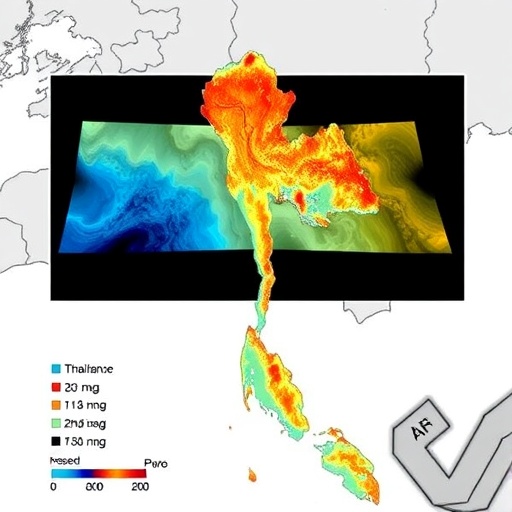In an era where water scarcity and environmental degradation loom large, the imperative to protect our precious water resources has never been more critical. Recent advancements in technology are enabling researchers to better understand and manage groundwater resources, particularly in areas that are facing salinity risks. A groundbreaking study led by a team of scientists, including M. Heydarizad, Z. Liu, and N. Pumijumnong, has made significant strides in tackling the challenges posed by groundwater salinity in the lower Chao Phraya River Basin in Thailand. Their work showcases the innovative application of deep learning techniques in environmental monitoring and decision support systems.
Groundwater salinity is a pressing issue, especially in regions where agricultural practices and urban development strain water resources. The infiltration of saline water into freshwater aquifers compromises the quality of drinking water and irrigation supplies, endangering both human health and agricultural productivity. The Chao Phraya River Basin, an area crucial for Thailand’s agriculture, is not immune to these threats. This study presents a forward-thinking approach that employs deep learning simulations to assess and mitigate the risks associated with groundwater salinity.
One of the standout features of this research is the development of a sophisticated deep learning simulation model capable of predicting salinity levels in groundwater. Traditional methods of monitoring salinity often rely on a limited number of sampling points, which may not accurately capture the spatial variability of salinity within larger aquifer systems. In contrast, the researchers harnessed the power of deep learning algorithms to analyze vast datasets, incorporating variables such as hydrological data, soil characteristics, and historical salinity measurements. This comprehensive approach enables the model to generate accurate predictions and identify areas at high risk for salinity intrusion.
The study carefully outlines the methodology used to train and validate the deep learning model. Researchers utilized a combination of supervised and unsupervised learning techniques, optimizing their model through rigorous testing and validation with real-world data. By doing so, they ensured the model’s reliability and efficiency in predicting salinity patterns. This is no small feat, as salinity dynamics can be influenced by a multitude of factors, including seasonal variations, land use changes, and climate conditions.
The implications of this research extend beyond predictive modeling. The authors have developed a decision support system that allows stakeholders, including policymakers and water resource managers, to use the model’s outputs to inform practical measures aimed at managing groundwater salinity. By visualizing salinity trends across different scenarios, decision-makers can devise targeted interventions to safeguard freshwater resources. This strategic approach ensures that limited resources are utilized efficiently and effectively, maximizing the benefits to local communities.
Moreover, the study highlights the importance of collaboration between scientists, policymakers, and local communities. By actively involving stakeholders throughout the research process, the authors have ensured that the findings are not only scientifically robust but also socially and economically relevant. This participatory approach fosters a sense of ownership among local populations, empowering them to take an active role in the sustainable management of their water resources.
The use of deep learning in environmental monitoring represents a significant advancement in the field of groundwater research. As technology continues to evolve, researchers can leverage powerful computational techniques to unlock insights that were previously unattainable. The implications of this research extend far beyond the specific context of the Chao Phraya River Basin. Similar methodologies could be adapted and applied in other regions facing groundwater salinity challenges, demonstrating the potential for a global impact.
As we face increasing pressures on water resources due to climate change, population growth, and urbanization, innovative solutions like those presented in this study will be essential. The intersection of technology and environmental science offers a pathway toward more resilient water management practices, helping to mitigate the risks associated with groundwater salinity. The potential for deep learning to transform how we monitor and manage our natural resources underscores the urgency of continuing to invest in research and innovation.
In conclusion, the research conducted by Heydarizad, Liu, and Pumijumnong marks a significant milestone in the pursuit of sustainable groundwater management. By employing deep learning techniques, they have provided a robust framework for assessing and addressing the risks posed by salinity in the Chao Phraya River Basin. Their findings underscore the potential for technology to play a pivotal role in solving pressing environmental challenges, paving the way for a more resilient and sustainable future for groundwater resources. As we look ahead, it is clear that the integration of advanced modeling techniques with stakeholder engagement will be crucial in ensuring the sustainability of our vital water supplies.
In the quest to protect and manage groundwater resources, studies like this reaffirm the value of interdisciplinary collaboration, combining expertise from hydrology, computer science, and environmental policy. The world is watching as innovative solutions unfold, providing hope and direction for those grappling with the complexities of water management in an ever-changing global landscape.
Through the lens of technology and collaboration, we are reminded that the future of our water resources lies not only in understanding the challenges we face but also in harnessing the tools at our disposal to create meaningful change. The journey towards effective groundwater salinity risk assessment is just beginning, but with efforts like those demonstrated in this study, we are better equipped to secure our vital liquid resources for generations to come.
Subject of Research: Groundwater salinity risk assessment using deep learning
Article Title: Deep learning simulation and decision support system for groundwater salinity risk assessment in the lower Chao Phraya River Basin, Thailand
Article References:
Heydarizad, M., Liu, Z., Pumijumnong, N. et al. Deep learning simulation and decision support system for groundwater salinity risk assessment in the lower Chao Phraya River Basin, Thailand. Environ Monit Assess 197, 1202 (2025). https://doi.org/10.1007/s10661-025-14681-4
Image Credits: AI Generated
DOI: 10.1007/s10661-025-14681-4
Keywords: Groundwater, Salinity, Deep learning, Decision support system, Environmental monitoring.




